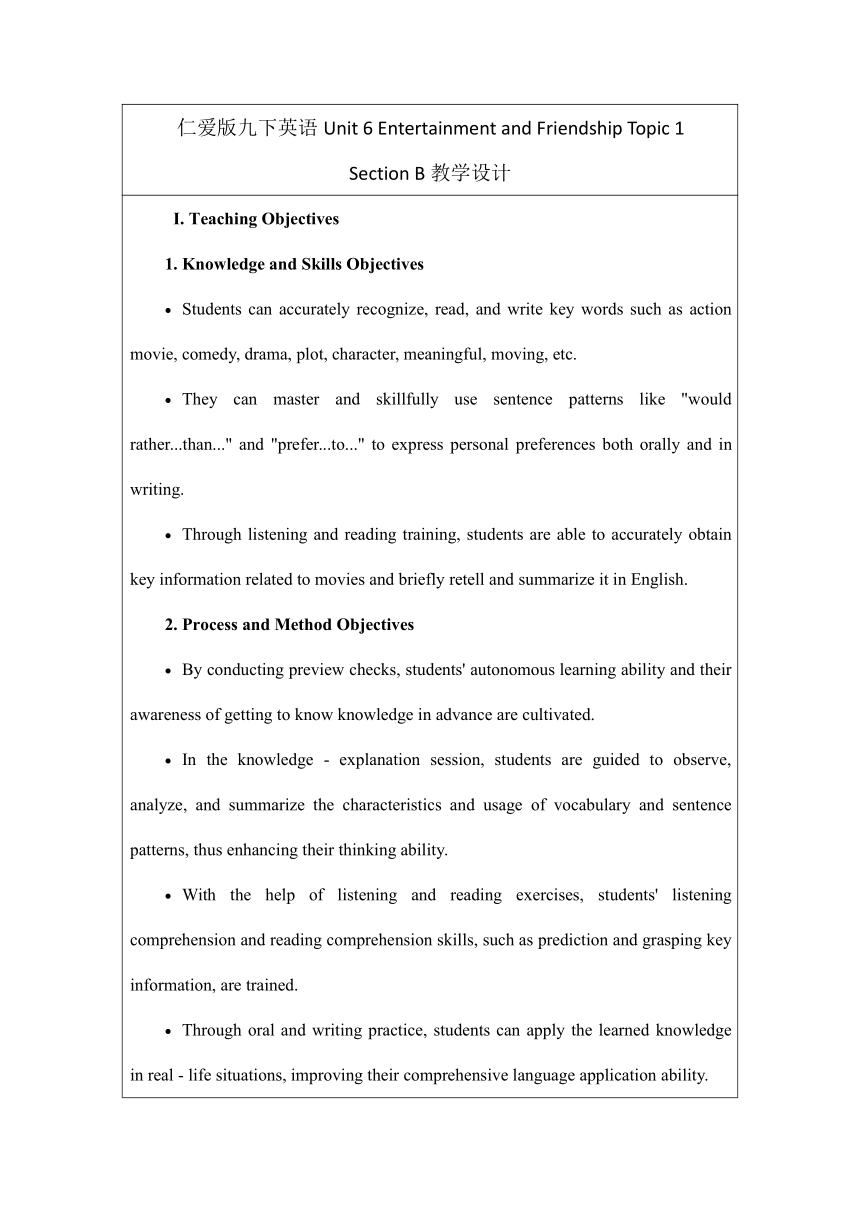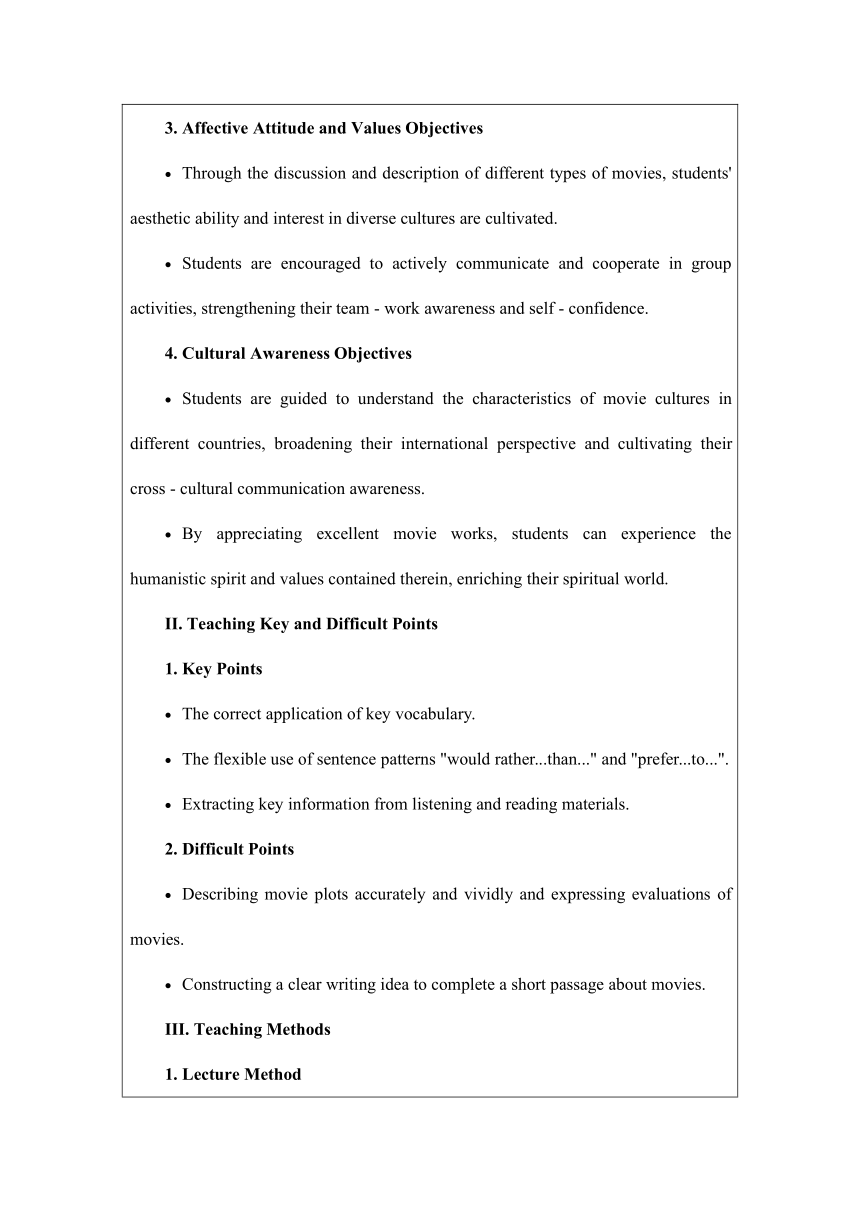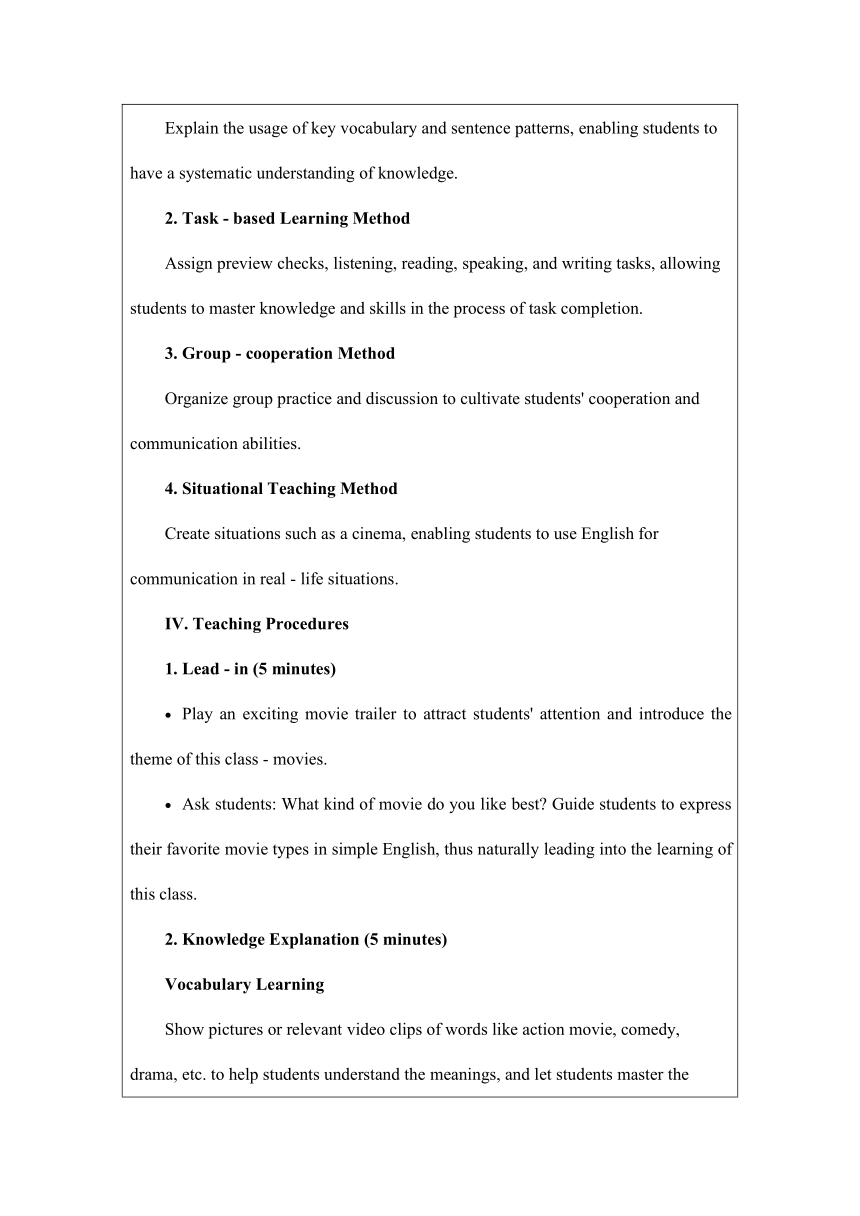仁爱版九下英语Unit 6 Entertainment and Friendship Topic 1 Section B 教学设计(表格式)
文档属性
| 名称 | 仁爱版九下英语Unit 6 Entertainment and Friendship Topic 1 Section B 教学设计(表格式) |

|
|
| 格式 | doc | ||
| 文件大小 | 59.6KB | ||
| 资源类型 | 教案 | ||
| 版本资源 | 仁爱科普版 | ||
| 科目 | 英语 | ||
| 更新时间 | 2025-01-20 17:36:52 | ||
图片预览



文档简介
仁爱版九下英语Unit 6 Entertainment and Friendship Topic 1 Section B教学设计
I. Teaching Objectives1. Knowledge and Skills ObjectivesStudents can accurately recognize, read, and write key words such as action movie, comedy, drama, plot, character, meaningful, moving, etc.They can master and skillfully use sentence patterns like "would rather...than..." and "prefer...to..." to express personal preferences both orally and in writing.Through listening and reading training, students are able to accurately obtain key information related to movies and briefly retell and summarize it in English.2. Process and Method ObjectivesBy conducting preview checks, students' autonomous learning ability and their awareness of getting to know knowledge in advance are cultivated.In the knowledge - explanation session, students are guided to observe, analyze, and summarize the characteristics and usage of vocabulary and sentence patterns, thus enhancing their thinking ability.With the help of listening and reading exercises, students' listening comprehension and reading comprehension skills, such as prediction and grasping key information, are trained.Through oral and writing practice, students can apply the learned knowledge in real - life situations, improving their comprehensive language application ability.3. Affective Attitude and Values ObjectivesThrough the discussion and description of different types of movies, students' aesthetic ability and interest in diverse cultures are cultivated.Students are encouraged to actively communicate and cooperate in group activities, strengthening their team - work awareness and self - confidence.4. Cultural Awareness ObjectivesStudents are guided to understand the characteristics of movie cultures in different countries, broadening their international perspective and cultivating their cross - cultural communication awareness.By appreciating excellent movie works, students can experience the humanistic spirit and values contained therein, enriching their spiritual world.II. Teaching Key and Difficult Points1. Key PointsThe correct application of key vocabulary.The flexible use of sentence patterns "would rather...than..." and "prefer...to...".Extracting key information from listening and reading materials.2. Difficult PointsDescribing movie plots accurately and vividly and expressing evaluations of movies.Constructing a clear writing idea to complete a short passage about movies.III. Teaching Methods1. Lecture MethodExplain the usage of key vocabulary and sentence patterns, enabling students to have a systematic understanding of knowledge.2. Task - based Learning MethodAssign preview checks, listening, reading, speaking, and writing tasks, allowing students to master knowledge and skills in the process of task completion.3. Group - cooperation MethodOrganize group practice and discussion to cultivate students' cooperation and communication abilities.4. Situational Teaching MethodCreate situations such as a cinema, enabling students to use English for communication in real - life situations.IV. Teaching Procedures1. Lead - in (5 minutes)Play an exciting movie trailer to attract students' attention and introduce the theme of this class - movies.Ask students: What kind of movie do you like best Guide students to express their favorite movie types in simple English, thus naturally leading into the learning of this class.2. Knowledge Explanation (5 minutes)Vocabulary LearningShow pictures or relevant video clips of words like action movie, comedy, drama, etc. to help students understand the meanings, and let students master the usage of vocabulary through examples. For example, show the fighting scenes of an action movie to introduce "action movie", and give an example: I like action movies because they are full of excitement.Sentence Pattern LearningBy comparing the structures and examples of the two sentence patterns "would rather...than..." and "prefer...to...", help students understand the differences in their usage. For example: I would rather watch TV than play computer games. and She prefers reading books to watching TV. Let students imitate and make sentences, and the teacher corrects mistakes in a timely manner.3. Listening Improvement (5 minutes)Before - listening PreparationAsk students to read the listening questions and predict the movie types and relevant information that may be involved in the listening content, such as characters and plots.During - listening ProcessPlay the listening material. Let students listen for the first time to understand the general theme of the dialogue and answer: What kind of movie are they talking about Listen for the second time to complete the detailed questions, such as: The plot of the movie is very ______. The main character is a ______.After - listening ReflectionAsk students to read aloud after the listening text to correct their pronunciation. At the same time, ask students to share the parts they didn't hear clearly during the listening process and the reasons, and the teacher gives guidance and suggestions.4. Reading Exploration (5 minutes)Fast ReadingDistribute a short passage about a certain movie. Let students skim it quickly and answer: What's the name of the movie What's it mainly about Cultivate students' ability to quickly obtain the main idea of the text.Intensive ReadingAsk students to read the passage carefully again and answer questions: What are the main characters like What's the ending of the movie Guide students to pay attention to the details of the text.Knowledge SummaryAsk students to mark the key vocabulary, phrases, and sentence patterns in the passage, such as "would rather...than...", "prefer...to...", etc., and conduct sentence - making exercises to deepen their understanding and application of knowledge.5. Oral Expression (10 minutes)Situational SimulationSuppose students are in a cinema, discussing the movie to watch with friends. The teacher first gives an example dialogue, such as: A: What kind of movie would you rather watch, an action movie or a comedy B: I would rather watch an action movie. I prefer exciting movies. What about you A: I prefer comedies. They can make me laugh.Group PracticeDivide students into groups. Let group members conduct similar dialogue exercises, and each member should participate in the expression. Then select a representative from each group to present, and the teacher gives evaluations and feedback.6. Writing Training (10 minutes)Writing TaskAssign a writing task, asking students to write a short passage introducing their favorite movie, including the movie type, plot, main characters, and reasons for liking it.Writing GuidanceGuide students to construct a writing idea, such as introducing the name and type of the movie at the beginning, describing the main plot and main characters in the middle, and stating the reasons for liking the movie at the end. Provide some common expressions and conjunctions, such as: The story is about...; At the beginning...; In the end...; I like this movie because... etc.Writing PracticeStudents write according to the outline. After completion, they exchange and read each other's writings in groups, make modification suggestions, and finally, the teacher selects some students' compositions for display and comments.7. Classroom Summary (3 minutes)Review the key vocabulary, phrases, and sentence patterns learned in this class with students, such as action movie, comedy, would rather...than..., etc.Summarize the gains and deficiencies in listening, reading, speaking, and writing exercises, and encourage students to continue strengthening practice after class.8. Homework Assignment (2 minutes)Complete the relevant exercises in the textbook to consolidate the knowledge learned in class.Watch a movie they like and write a movie review to share with classmates in the next class, further improving students' comprehensive English application ability.V. Teaching ReflectionDuring the teaching process, pay attention to students' participation and mastery. Adjust the teaching rhythm and methods in a timely manner. Provide targeted guidance for the problems students have in speaking and writing. At the same time, encourage students to actively express their opinions and ideas, cultivating students' innovative thinking and language application ability. In future teaching, more diverse teaching resources, such as movie clips and English movie reviews, can be introduced to let students better feel the charm of the English language and culture.
I. Teaching Objectives1. Knowledge and Skills ObjectivesStudents can accurately recognize, read, and write key words such as action movie, comedy, drama, plot, character, meaningful, moving, etc.They can master and skillfully use sentence patterns like "would rather...than..." and "prefer...to..." to express personal preferences both orally and in writing.Through listening and reading training, students are able to accurately obtain key information related to movies and briefly retell and summarize it in English.2. Process and Method ObjectivesBy conducting preview checks, students' autonomous learning ability and their awareness of getting to know knowledge in advance are cultivated.In the knowledge - explanation session, students are guided to observe, analyze, and summarize the characteristics and usage of vocabulary and sentence patterns, thus enhancing their thinking ability.With the help of listening and reading exercises, students' listening comprehension and reading comprehension skills, such as prediction and grasping key information, are trained.Through oral and writing practice, students can apply the learned knowledge in real - life situations, improving their comprehensive language application ability.3. Affective Attitude and Values ObjectivesThrough the discussion and description of different types of movies, students' aesthetic ability and interest in diverse cultures are cultivated.Students are encouraged to actively communicate and cooperate in group activities, strengthening their team - work awareness and self - confidence.4. Cultural Awareness ObjectivesStudents are guided to understand the characteristics of movie cultures in different countries, broadening their international perspective and cultivating their cross - cultural communication awareness.By appreciating excellent movie works, students can experience the humanistic spirit and values contained therein, enriching their spiritual world.II. Teaching Key and Difficult Points1. Key PointsThe correct application of key vocabulary.The flexible use of sentence patterns "would rather...than..." and "prefer...to...".Extracting key information from listening and reading materials.2. Difficult PointsDescribing movie plots accurately and vividly and expressing evaluations of movies.Constructing a clear writing idea to complete a short passage about movies.III. Teaching Methods1. Lecture MethodExplain the usage of key vocabulary and sentence patterns, enabling students to have a systematic understanding of knowledge.2. Task - based Learning MethodAssign preview checks, listening, reading, speaking, and writing tasks, allowing students to master knowledge and skills in the process of task completion.3. Group - cooperation MethodOrganize group practice and discussion to cultivate students' cooperation and communication abilities.4. Situational Teaching MethodCreate situations such as a cinema, enabling students to use English for communication in real - life situations.IV. Teaching Procedures1. Lead - in (5 minutes)Play an exciting movie trailer to attract students' attention and introduce the theme of this class - movies.Ask students: What kind of movie do you like best Guide students to express their favorite movie types in simple English, thus naturally leading into the learning of this class.2. Knowledge Explanation (5 minutes)Vocabulary LearningShow pictures or relevant video clips of words like action movie, comedy, drama, etc. to help students understand the meanings, and let students master the usage of vocabulary through examples. For example, show the fighting scenes of an action movie to introduce "action movie", and give an example: I like action movies because they are full of excitement.Sentence Pattern LearningBy comparing the structures and examples of the two sentence patterns "would rather...than..." and "prefer...to...", help students understand the differences in their usage. For example: I would rather watch TV than play computer games. and She prefers reading books to watching TV. Let students imitate and make sentences, and the teacher corrects mistakes in a timely manner.3. Listening Improvement (5 minutes)Before - listening PreparationAsk students to read the listening questions and predict the movie types and relevant information that may be involved in the listening content, such as characters and plots.During - listening ProcessPlay the listening material. Let students listen for the first time to understand the general theme of the dialogue and answer: What kind of movie are they talking about Listen for the second time to complete the detailed questions, such as: The plot of the movie is very ______. The main character is a ______.After - listening ReflectionAsk students to read aloud after the listening text to correct their pronunciation. At the same time, ask students to share the parts they didn't hear clearly during the listening process and the reasons, and the teacher gives guidance and suggestions.4. Reading Exploration (5 minutes)Fast ReadingDistribute a short passage about a certain movie. Let students skim it quickly and answer: What's the name of the movie What's it mainly about Cultivate students' ability to quickly obtain the main idea of the text.Intensive ReadingAsk students to read the passage carefully again and answer questions: What are the main characters like What's the ending of the movie Guide students to pay attention to the details of the text.Knowledge SummaryAsk students to mark the key vocabulary, phrases, and sentence patterns in the passage, such as "would rather...than...", "prefer...to...", etc., and conduct sentence - making exercises to deepen their understanding and application of knowledge.5. Oral Expression (10 minutes)Situational SimulationSuppose students are in a cinema, discussing the movie to watch with friends. The teacher first gives an example dialogue, such as: A: What kind of movie would you rather watch, an action movie or a comedy B: I would rather watch an action movie. I prefer exciting movies. What about you A: I prefer comedies. They can make me laugh.Group PracticeDivide students into groups. Let group members conduct similar dialogue exercises, and each member should participate in the expression. Then select a representative from each group to present, and the teacher gives evaluations and feedback.6. Writing Training (10 minutes)Writing TaskAssign a writing task, asking students to write a short passage introducing their favorite movie, including the movie type, plot, main characters, and reasons for liking it.Writing GuidanceGuide students to construct a writing idea, such as introducing the name and type of the movie at the beginning, describing the main plot and main characters in the middle, and stating the reasons for liking the movie at the end. Provide some common expressions and conjunctions, such as: The story is about...; At the beginning...; In the end...; I like this movie because... etc.Writing PracticeStudents write according to the outline. After completion, they exchange and read each other's writings in groups, make modification suggestions, and finally, the teacher selects some students' compositions for display and comments.7. Classroom Summary (3 minutes)Review the key vocabulary, phrases, and sentence patterns learned in this class with students, such as action movie, comedy, would rather...than..., etc.Summarize the gains and deficiencies in listening, reading, speaking, and writing exercises, and encourage students to continue strengthening practice after class.8. Homework Assignment (2 minutes)Complete the relevant exercises in the textbook to consolidate the knowledge learned in class.Watch a movie they like and write a movie review to share with classmates in the next class, further improving students' comprehensive English application ability.V. Teaching ReflectionDuring the teaching process, pay attention to students' participation and mastery. Adjust the teaching rhythm and methods in a timely manner. Provide targeted guidance for the problems students have in speaking and writing. At the same time, encourage students to actively express their opinions and ideas, cultivating students' innovative thinking and language application ability. In future teaching, more diverse teaching resources, such as movie clips and English movie reviews, can be introduced to let students better feel the charm of the English language and culture.
同课章节目录
- Unit 5 China and the world
- Topic 1 China attracts millions of tourists from a
- Topic 2 He is really the pride of China.
- Topic 3 Now it is a symbol of England.
- Unit 6 Entertainment and Friendship.
- Topic 1 I would rather watch sports shows than tho
- Topic 2 Who is your favorite character in literatu
- Topic 3 I will remember our friendship forever.
